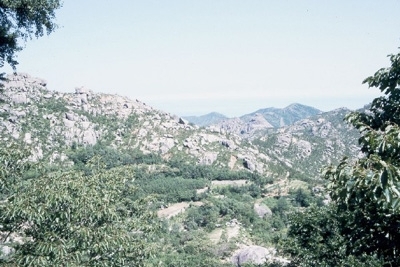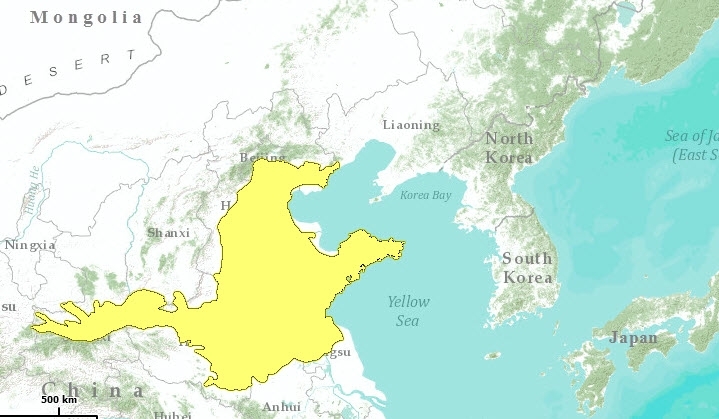Huang He Plain mixed forests
The Huang He Plain mixed forest coregion occupies the lower plain of the Yellow Riverand consists of silt that has been transported from the loess hills of North Central China. River deposition on the North China Plain has created fertile soil, well-suited for agriculture. Since the land has been settled and farmed for several thousand years, few remnants of the original lowland forest exist. Some stands remain on surrounding hills, and in the Dabie Mountains. Riparian wetlands and flood basins still serve as important refueling stops for large numbers of migratory birds.
Beginning in the 1960s numerous hydroelectric dams have been constructed on various reaches of the Yellow River, leading to massive ecological damage; even earlier, the instinct to control flooding on the North China Plain has led to levee construction, which activity has actually resulted in exacerbation of larger flood events, and also to major changes in the lower reach course. The Huange He ecoregion has been heavily degraded by millennia of deforestation and intensive human use.
Location and General Description
The Huang He Plain mixed forest ecoregion expands to the east as the floodplains of the Yellow River broaden as they approach the sea. To the south, this ecoregion intergrades imperceptibly into the floodplain of the lower Changjiang (Yangtze) River. The watershed divide between the lower reaches of these two great rivers is low enough that they have been linked for centuries by navigation canals. Most of this ecoregion is occupied by the North China Plain, an area of recent alluvium where the particle size and porosity of the substrate varies with the slope of the land. Many areas, even those farther inland, experience salinization of the soil. Some low hills and mountains rise to the south of the Huang He, and on the rocky Shandong Peninsula, which is included here. To the east, the hills are mostly less than 300 meters (m) elevation. To the west, the highest peak, Taishan, rises to 1,524 m. These mountains are much older than those of western China, containing metamorphic rocks of the Cambrian Period.
Warm, moist summers, cold winters and favorable [[soil]s] produce deciduous broadleaf forests. Such forests are thought to have existed in the area at one time, although they were virtually extirpated centuries if not millennia ago. Nearby hills are also heavily disturbed, but do retain some vestiges of their original forest cover. Natural vegetation of the Shandong Peninsula includes forests dominated by the deciduous oaks, Quercus acutissima and Q. variabilis, with other tree species including elm (Ulmus spp.), pistachio (Pistacia chinensis), and the conifer (Pinus tabulaeformis). Today these original forests have been replaced by a secondary cover of red pine (P. densiflora).
The northeastern part of Shandong Peninsula was connected to the northerly Dalian Peninsula of Liaoning Province during the Pleistocene. Today, some northern forest trees characteristic of northeastern China still occur here. Characteristic tree species are Quercus mongolica, Tilia spp. and Corylus heterophylla. Secondary forests on the Shandong Peninsula tend to support native conifers such as Pinus armandi, P. tabulaeformis, or several other pine (Pinus spp.) and larch (Larix spp.) species that have been introduced from other areas. The oak Q. variabilis also occurs here.
Higher mountains further inland support mixed forest stands dominated by P. tabulaeformis (below 700 m) and the cypress Platycladus orientalis (above 700 m).
Biodiversity Features
The Shandong Peninsula is of significance as a nesting area for seabirds like the White-tailed Sea Eagle (Haliaeetus albicilla) and terrestrial species like the Great Bustard (Otis tarda), both of which are protected species. Rongcheng Nature Reserve, at the eastern tip of the peninsula, serves as a staging ground for migratory waterfowl such as swans (Cynus spp.) and cranes (Grus spp.) Scaly-sided Mergansers (Merganser squamatus) have been recorded here in winter.
Notable mammals found in this lower part of the Yellow River Basin are the Sika Deer (Cervus nippon), which is also distributed across the Ordos region. Other mammals that occur in the ecoregion are the Near Threatened Birdlike Noctule (Nyctalus aviator); the Vulnerable Chinese Water Deer (Hydropotes inermis); the Endangered Dhole (Cuon alpinus), the Endangered Golden Snub-nosed Monkey (Pygathrix roxellana), although the main range is in the upper basin.
Amphibians occurring in the Huang He Plain mixed forests ecoregion include the Boie's Wart Frog (Fejervarya limnocharis); the Taiwanese Frog (Hoplobatrachus rugulosus); the Swelled Vent Frog (Nanorana quadranus); Manchurian Narrowmouth Toad (Kaloula borealis); Gold-spotted Pond Frog (Pelophylax plancyi). Most of the Anurans surviving in this greatly human-modified ecoregion are those taxa that can adapt to breeding in ditches, man made ponds and rice paddies.
Reptiles found on the Huang He Plain include the Assam Green Trinket Snake (Gonyosoma frenatum), Cantor's Rat Snake (Ptyas dhumnades), Red Banded Snake (Dinodon rufozonatum), and Shanxi Gecko (Gekko auriverrucosus). In the mouth region of the Yellow River is found the widespread Yellow-bellied Sea Snake (Pelamis platura).
The rare and Endangered Red-crowned Crane (Grus japonensis) has a Chinese wintering population, which utilises the Amur Basin and also the Huang He Plain and Korea; there is a separate Japanese population centred in Hokkaido.
Species richness of various taxonomic groups is generally low, due to the homogeneous habitat, distance from the tropics, and thousands of years of intensive anthropogenic activity. There are no first-class or second-class protected plants in the ecoregion, although Shandong Province lists eight plant species that are endangered. Mammal species richness is the third lowest of all provinces.
Current Status
The Huang He Plain itself contains relatively few areas of intact habitat. Some wetland and lake areas such as Nansi Hu Nature Reserve (1200 square kilometers) offer winter habitat for migratory waterfowl, but these areas are heavily disturbed by fishermen, farmers, and aquaculturists.
Most habitat in this ecoregion has been significantly modified and much of the protected land in this ecoregion is comprised of secondary scrub and grassland. There is a severe lack of protected habitat representing the major potential vegetation types, including deciduous broadleaf forest and swamp grasslands.
Existing forest reserves in hill areas, wetlands and coastal relict [[habitat]s] could all benefit from improved management of the region’s nature reserves. Taishan would benefit from a better delineation of its core and buffer zone areas.
Types and Severity of Threats
Hunting and pesticide use contribute to ongoing pressure on wildlife populations. Conservation education is one place to begin raising awareness of the importance of wildlife conservation. Restoration efforts could begin in the future.
Justification of Ecoregion Delineation
This ecoregion consists of wide expanses of alluvial plains of the Huang He (Yellow) River, mostly devoted to agriculture, together with adjacent low mountains and hills. The CVMCC Vegetation Map of China shows remaining patches of natural vegetation as temperate mixed forests. These forests are completely surrounded by agriculture. This entire area is comparable to the North China Plain biogeographic subunit in the Oriental Deciduous Forests according to Mackinnon.
Further Reading
- Chinese Vegetation Map Compilation Committee. 1979. Vegetation map of China. Map (1:10,000,000). Science Press, Beijing, China. ISBN: 7030089561
- Laidler, Liz, and Keith Laidler. 1996. China’s Threatened Wildlife. Blandford, London.
- MacKinnon, J. 1996. Wild China. The MIT Press, Cambridge MA. ISBN: 0262133296
- Mackinnon, J., M. Sha, C. Cheung, G. Carey, Z. Xiang, and D. Melville. 1996. A biodiversity review of China. World Wide Fund for Nature, Hong Kong.
- Zhao, J., editor. Zheng Guangmei, Wang Huadong, Xu Jialin. 1990. The Natural History of China. McGraw Hill Publishing Company, New York. ISBN: 0002190435
| Disclaimer: This article is contains some information that was originally published by the World Wildlife Fund. Topic editors and authors for the Encyclopedia of Earth have edited its content and added new information. The use of information from the World Wildlife Fund should not be construed as support for or endorsement by that organization for any new information added by EoE personnel, or for any editing of the original content. |


%2c_Shandong_province%2c_China2.jpg)